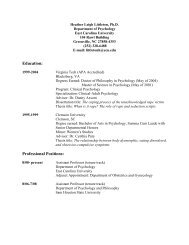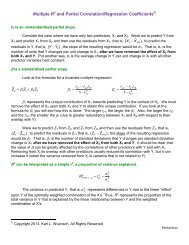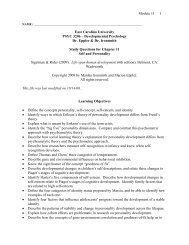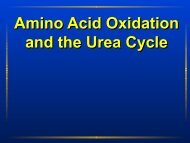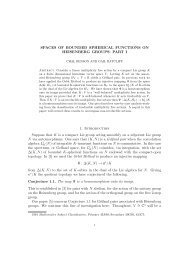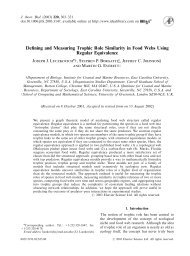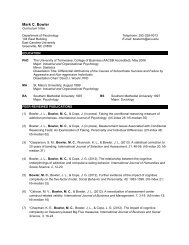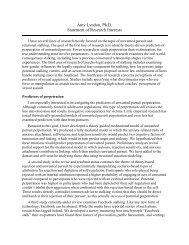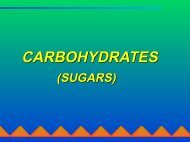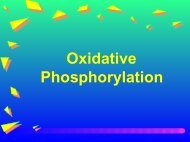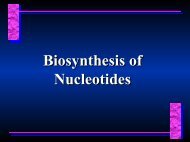Nitrogen Acquisition and Amino Acid Biosynthesis - Ecu
Nitrogen Acquisition and Amino Acid Biosynthesis - Ecu
Nitrogen Acquisition and Amino Acid Biosynthesis - Ecu
Create successful ePaper yourself
Turn your PDF publications into a flip-book with our unique Google optimized e-Paper software.
<strong>Amino</strong> <strong>Acid</strong><strong>Biosynthesis</strong>
Plants <strong>and</strong> microbes synthesize all20 amino acidsThe amino group is derived fromglutamate via transamination of thecorresponding α-keto acidMammals can sythesize only 10 ofthe 20 amino acids
Nonessential amino acids: thosethat can be synthesizedEssential amino acids: those thatcannot be synthesized
EssentialArginineHistidineIsoleucineLeucineLysineMethioninePhenylalanineThreonineTryptophanValineNonessentialAlanineAsparagineAspartateCysteineGlutamateGlutamineGlycineProlineSerineTyrosine
<strong>Amino</strong> <strong>Acid</strong>s are derived fromintermediates in glycolysis; TCAcycle; pentose phosphatepathway<strong>Amino</strong> acids are classifiedaccording to the source for theircorresponding α-keto acid
GlucoseGlucose-6-PO 4Ribose-5-PO 4HistidineErythrose-4-PO43-PGASerineTryptophan; Phenylalanine;TyrosineAspartatePEPPyruvateCitrateGlycine; CysteineAlanine; Valine; LeucineGlutamateOAAAsparagine; Methionine;Threonine; Lysine;Isoleucinea-KgGlutamine; Proline;Arginine
α−Kg FamilyGlutamateGlutamineProlineArginineLysinePyruvate FamilyAlanineValineLeucineAspartate FamilyAspartateAsparagineMethionineThreonineIsoleucineLysine3-Phosphoglycerate FamilySerineGlycineCysteine
PEP <strong>and</strong> Erythrose-4-P FamilyPhenylalanineTyrosineTryptophanHistidine is derived from PRPP(phosphoribosylpyrophosphate)
Transamination is one principleroute by which amino acids aresynthesized from theircorresponding α-keto acidsPredominant amino acid/α-keto acidpair is glutamate/α-Kg
a-Kg Family:Proline is derived from glutamate in a series of 4 reactionsthat involves reduction of the carboxyl R group to analdehyde which then spontaneously cyclizes.Arginine biosynthesis involves steps that are part of theurea cycle <strong>and</strong> depends on the formation of ornithine.Ornithine has three metabolic roles: 1) as a precursorto arginine; 2) as an intermediate in the urea cycle; 3) asan intermediate in Arginine degradation.
O H O-O-C-CH2-CH2-C-C-O -NH 3+O- O H OO=P-O-C-CH2-CH2-C-C-O -O-NH 3+Glutamate 5-PProlineO H OH-C-CH2-CH2-C-C-O -NH 3+Glutamate5-semialdehyde
Lysine biosynthesis in fungi stems froma-Kg; in other organisms it comes fromaspartate.Starting from a-Kg, the carbon chain islengthened by one Carbon in a series of stepsreminiscent of the TCA cycle:Acetyl CoA is condensed with a-Kg to formhomocitrate; homoisocitrate is formed;oxidative decarboxylation removed one carbonleaving the intermediate a-ketoadipate; 5additional steps then form lysine
O-C=OCH 2CH 2C=OC=OO-α-KgO-C=OO-C=OCH 2CH 2HO-C-C=OO-CH 2C=OO-HomocitrateO-C=OCH 2CH 2H-C-C=OHO-C-H O-C=OO-HomoisocitrateCH 2CH 2CH 2C=OC=OO-α-ketoadipate
Aspartate Family:Aspartate is formed by transamination ofOAA using glutamate as the amino groupdonorAsparagine is formed by the amidation of thecarboxyl R group of aspartate; in bacteria theamino group comes from NH 4+; in otherorganisms it comes from glutatmate
Threonine, methionine <strong>and</strong> lysinebiosynthesis in bacteria arises from thecommon precursor aspartate via theintermediate β-aspartyl semialdehyde
COO-HC-NH 3+ATPADPCOO-HC-NH 3+CH 2COO-CH 2O=C-O-PAspartateNADPHAspartyl-βphosphateCOO-NADP + + PHC-NH 3+CH 2O=C-Hβ-Aspartylsemialdehyde
Pyruvate Family:Alanine arises via transamination ofpyruvate with glutamate as the aminogroup donorValine, leucine <strong>and</strong> isoleucine are allessential amino acids; the intermediatea-ketoisovalerate is the precursor tovaline <strong>and</strong> leucine
3-PGA Family:3-PGA is a substrate for oxidation to form3-phosphohydroxypyruvate, which is an α-ketoacid transaminated by glutamate to yield3-phosphoserine. Dephosphorylation producesserine. Glycine is formed from CO 2, NH 4+,N 5 N 10 Methylenetetrahydrofolate. Cysteine isformed by the transfer of a sulfhydryl group toserine
O=C-O -HC-OHH 2C-O- PNAD+NADHO=C-O -C=OH 2C-O- P3-PGA3-Phosphohydroxypyruvateglutamateα-kgO=C-O -PH 2OO=C-O -HC-NH 3+H 2C-OHHC-NH 3+H 2C-O- PSerine3-Phosphoserine
PEP <strong>and</strong> Erythrose-4-P Family:The aromatic amino acids are synthesizedin a shared pathway that has chorismateas the key intermediate. Chorismate iscommon to the synthesis of compoundswith benzene rings including aminoacids, Q, Qb, Vitamins E <strong>and</strong> K, <strong>and</strong>lignin.Chorismate is synthesized via the shikimatepathway; <strong>and</strong> the precursors to shikimate arePEP <strong>and</strong> erythrose-4-P
Plants synthesize all 20 amino acids. Manyherbicides act as inhibitors of enzymes in theamino acid biosythetic pathways.Glyphosate (roundup) is a PEP analoguethat inhibits an enzyme in the shikimatepathway <strong>and</strong> shuts down synthesis ofaromatic amino acidsSulfmeturon methyl (Oust) inhibits valine,leucine, isoleucine synthesis<strong>Amino</strong>triazole (Amitrole) inhibits histidinesynthesis



